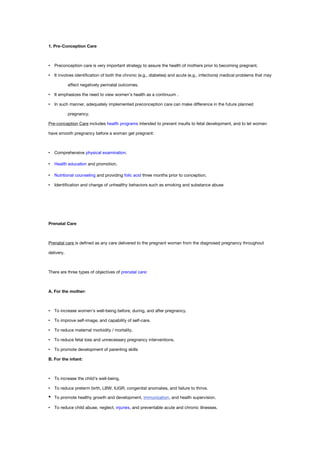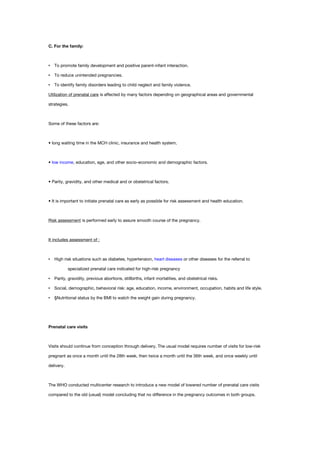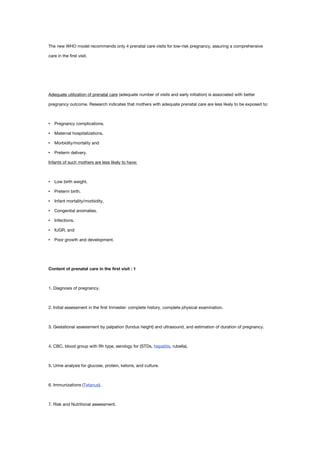Maternity
- 1. 1. Pre-Conception Care âĒ Preconception care is very important strategy to assure the health of mothers prior to becoming pregnant. âĒ It involves identification of both the chronic (e.g., diabetes) and acute (e.g., infections) medical problems that may affect negatively perinatal outcomes. âĒ It emphasizes the need to view womenâs health as a continuum . âĒ In such manner, adequately implemented preconception care can make difference in the future planned pregnancy. Pre-conception Care includes health programs intended to prevent insults to fetal development, and to let women have smooth pregnancy before a woman get pregnant: âĒ Comprehensive physical examination. âĒ Health education and promotion. âĒ Nutritional counseling and providing folic acid three months prior to conception. âĒ Identification and change of unhealthy behaviors such as smoking and substance abuse Prenatal Care Prenatal care is defined as any care delivered to the pregnant woman from the diagnosed pregnancy throughout delivery. There are three types of objectives of prenatal care: A. For the mother: âĒ To increase womenâs well-being before, during, and after pregnancy. âĒ To improve self-image, and capability of self-care. âĒ To reduce maternal morbidity / mortality. âĒ To reduce fetal loss and unnecessary pregnancy interventions. âĒ To promote development of parenting skills B. For the infant: âĒ To increase the childâs well-being. âĒ To reduce preterm birth, LBW, IUGR, congenital anomalies, and failure to thrive. âĒ To promote healthy growth and development, immunization, and health supervision. âĒ To reduce child abuse, neglect, injuries, and preventable acute and chronic illnesses.
- 2. C. For the family: âĒ To promote family development and positive parent-infant interaction. âĒ To reduce unintended pregnancies. âĒ To identify family disorders leading to child neglect and family violence. Utilization of prenatal care is affected by many factors depending on geographical areas and governmental strategies. Some of these factors are: âĒ long waiting time in the MCH clinic, insurance and health system. âĒ low income, education, age, and other socio-economic and demographic factors. âĒ Parity, gravidity, and other medical and or obstetrical factors. âĒ It is important to initiate prenatal care as early as possible for risk assessment and health education. Risk assessment is performed early to assure smooth course of the pregnancy. It includes assessment of : âĒ High risk situations such as diabetes, hypertension, heart diseases or other diseases for the referral to specialized prenatal care indicated for high-risk pregnancy âĒ Parity, gravidity, previous abortions, stillbirths, infant mortalities, and obstetrical risks. âĒ Social, demographic, behavioral risk: age, education, income, environment, occupation, habits and life style. âĒ §Nutritional status by the BMI to watch the weight gain during pregnancy. Prenatal care visits Visits should continue from conception through delivery. The usual model requires number of visits for low-risk pregnant as once a month until the 28th week, then twice a month until the 36th week, and once weekly until delivery. The WHO conducted multicenter research to introduce a new model of lowered number of prenatal care visits compared to the old (usual) model concluding that no difference in the pregnancy outcomes in both groups.
- 3. The new WHO model recommends only 4 prenatal care visits for low-risk pregnancy, assuring a comprehensive care in the first visit. Adequate utilization of prenatal care (adequate number of visits and early initiation) is associated with better pregnancy outcome. Research indicates that mothers with adequate prenatal care are less likely to be exposed to: âĒ Pregnancy complications. âĒ Maternal hospitalizations. âĒ Morbidity/mortality and âĒ Preterm delivery. Infants of such mothers are less likely to have: âĒ Low birth weight. âĒ Preterm birth. âĒ Infant mortality/morbidity. âĒ Congenital anomalies. âĒ Infections. âĒ IUGR, and âĒ Poor growth and development. Content of prenatal care in the first visit : 1 1. Diagnosis of pregnancy. 2. Initial assessment in the first trimester: complete history, complete physical examination. 3. Gestational assessment by palpation (fundus height) and ultrasound, and estimation of duration of pregnancy. 4. CBC, blood group with Rh type, serology for (STDs, hepatitis, rubella). 5. Urine analysis for glucose, protein, ketons, and culture. 6. Immunizations (Tetanus). 7. Risk and Nutritional assessment.
- 4. 8. Health education: this is a golden opportunity for health care providers. Many health issues can be discussed with the pregnant lady regarding healthy behaviors promotion, risk reduction, and awareness of danger sings: âĒ Vaginal bleeding âĒ Persistent vomiting âĒ Chills or fever âĒ Dysuria âĒ Abdominal pain or uterine cramping âĒ Swelling of the face or fingers âĒ Visual disturbances âĒ Oliguria âĒ Leakage of fluids âĒ Decrease in fetal movements âĒ Sings of preterm labor. Nursing Care during Subsequent Visits: 1. Weight gain assessment by BMI (weight / hightÂē): âĒ Underweight <19.9 â 13 kg. âĒ Normal 19.9-26 â 9 kg. âĒ Overweight > 26 â 7 kg 2. Blood pressure, urinalysis, examination of the abdomen. 3. Glucose tolerance testing at 28 weeks. 4. Iron, folic acid, prenatal multivitamin. 5. Reducing psychosocial and environmental risks.





